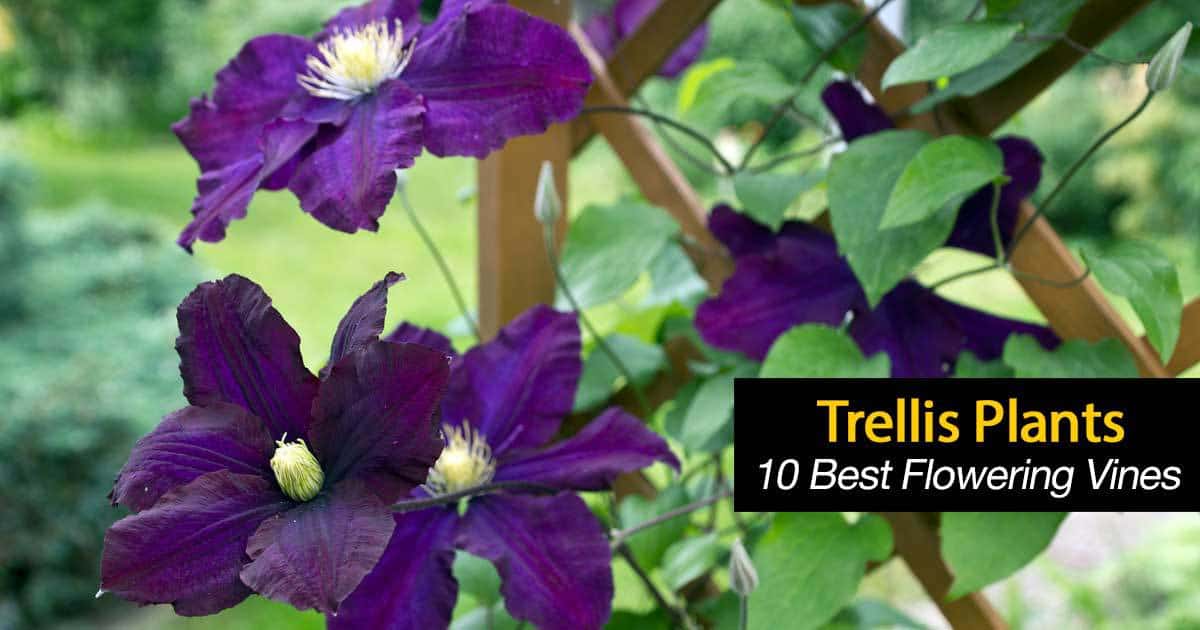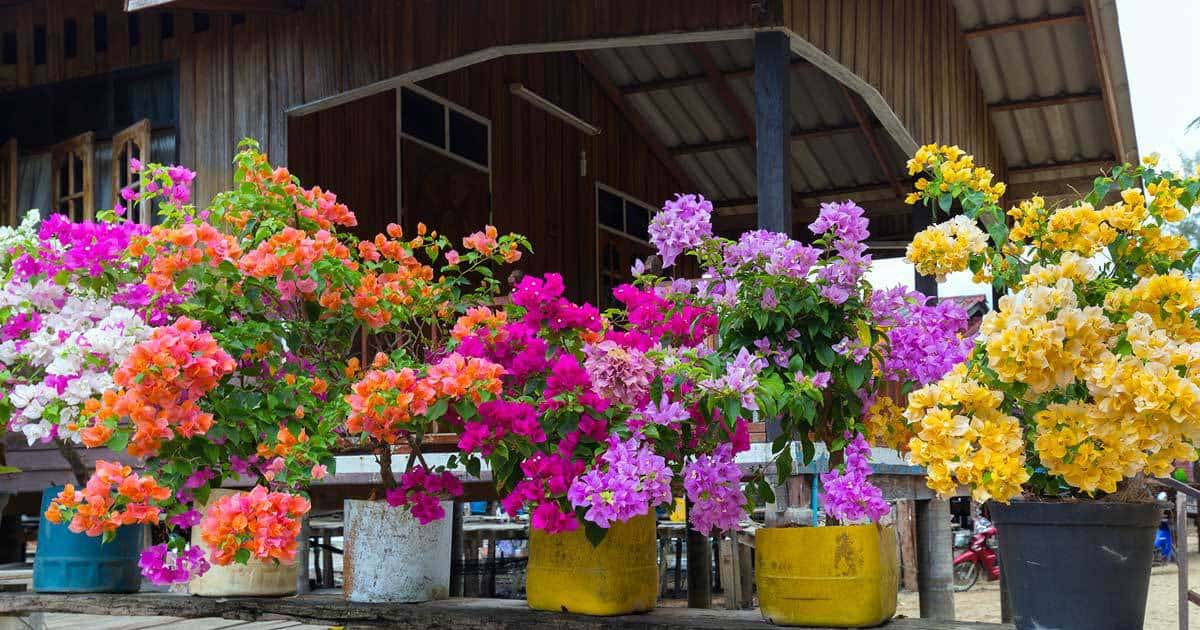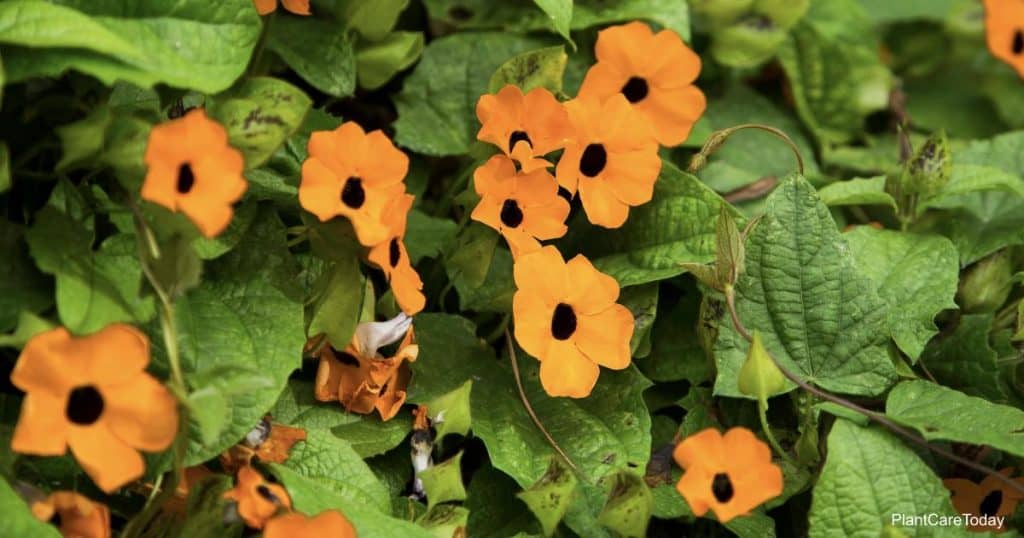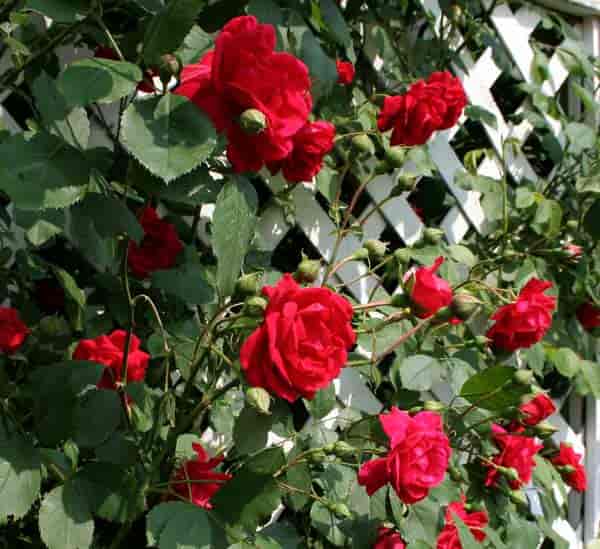Choosing the ideal trellis plants that flower can be a challenging decision. There are plenty of climbing plants and flowering vines for growing on a trellis system.
Each of the flowering vines has their own beauty and characteristics.
There are many creative ideas and products on how to mix flowers and give your garden and property a beautiful accent.
To make your garden entrance attractive, use flowering vines with dark foliage with flowers in multiple colors to attract the butterfly.
You don’t need to spend three days to build a trellis. Divide the whole project into three stages: measuring the size of the trellis, combining the panels, and installing them into the ground.
Some wood source and unusual items that make great trellis materials include:
- Wood trellis (wood cedar or pressure-treated wood)
- Old fishing net
- Cucumber trellis
- Willow trellis
- Antique headboard trellis
- Kee klamp pipe fittings
- PVC pipe
- Stakes and posts
While wood trellis makes a great design to your garden, metal trellis or trellis wire gives additional security.
More about: Is pressure treated wood safe for vegetable gardens?
You can try sturdy beam and bar, or powder-coated steel. You can even use a tomato trellis. Read on to learn more about different trellis flowers and ideas.
10 Of The Best Flowering Trellis Plants and Vines For Vertical Gardening:
#1 – Jewel of Africa Nasturtium
These flowering Nasturtium vines are available in shades of orange, maroon, salmon, yellow, apricot and red. With high appealing, colorful flowers and green leaves, this vine resembles a stunning painting.
The Nasturtium vine will flourish and bloom in full sun. Their blooming season is from June – September hardy in USDA zones of 10b and 11A.
They are easy to grow and do well if maintained as recommended making them one of the best climbing plants.
#2 – Mandevilla
How to care for Mandevilla?
Mandevilla plant vines are sun-lovers and grow upward with the help of tendrils. You won’t waste time tying up the climbing shoots. Provide convenient trellis panels or an arbor, the plant will do the rest.
Mandevilla blossoms are 3.5″ inches and come in deep reds, mandevilla pink, and white flower colors. Their flowers appear during the spring-summer season.
NOTE: Mandevilla vines can be overwintered.
#3 – Campsis Radicans
This flowering vine has trumpet-shaped flowers which made it be known as Trumpet creeper vine.
The flowers have a yellow throat and turn their color from orange to red.
The attractive colors of the trumpet vine attract hummingbirds to the flower garden. They are ideal for a vine for pergolas, on a trellis, and arches as they are best climbers.
They can reach up to a height of 25′ to 45′ feet tall. For it to bloom, the vine has to receive full sunlight, but the leaves can still do well in the partial shade.
One of the best plants for trellis.
#4 – Henryi Clematis
This vine offers a striking view in the summer as they have gorgeous daisy-shaped flowers and dark green foliage.
The vine plants grow best under direct sunlight. Flowers start to appear in early summer. They can be seen throughout the summer season.
The Henryi Clematis reaches a height of 6′ feet and a spread of 3′ to 5′ feet. Its flowers are absolutely splendid with creamy color and a darkened center. It’s a favorite among the gardeners.
#5 – Clematis
 For those who want a Clematis vine for your arbor or trellis, you’ll have to settle for the taller varieties of clematis.
For those who want a Clematis vine for your arbor or trellis, you’ll have to settle for the taller varieties of clematis.
They start to bloom during the early spring and can grow intensively; after one season, the entire structure will be covered in Clematis.
They are pretty easy to grow and require little maintenance… but they are fast-growing flowering vines.
So much so that at the end of the year, your garden will be covered by the colorful and intriguing flowers of this vine.
Learn about Clematis Jackmanii growing and care.
#6 – Zephirine Drouhin Rose
These vine flowers have inimitable roses on them and are among the best climbers. They have thorn-less canes and have a gorgeous burgundy color that will make your garden stunning.
Because of their flexible canes, these vines are widely used to decorate the garden as they are easy to wrap around the arches or pergolas in the garden. They grow to a 15′ feet tall.
They bloom well even in the shade. Therefore, if your garden doesn’t experience enough sunlight, then Zephirine Drouhin Rose can be a suitable choice for your garden.
#7 – Morning Glory
They are saucer-shaped flowers and bloom early in the morning hence the name “Morning Glory”. Their striking beauty makes Morning Glories an ideal decorating vine and flower for any garden trellis design.
They have heart-shaped leaves that have a length of 4″-5″ inches. They appear in shades of red, blue, yellow, and purple colors. This purple vines plant can reach up a height of 10′ feet depending on the growing conditions.
They thrive in subtropical and temperate regions and areas with dry soil. Growing them is not much of hassle as long as you plant them in a place with plenty of direct sunlight.
#8 – Bougainvillea
 For those looking for something floriferous, colorful, and bright in their flower or vegetable gardens, the Bougainvillea plant can be an ideal choice.
For those looking for something floriferous, colorful, and bright in their flower or vegetable gardens, the Bougainvillea plant can be an ideal choice.
These plants can be used as hedges, grown as bushes, on fences and tied to a trellis. Plants can grow to a height of 20′ feet tall depending on the variety.
They are considered the ideal climbing flowers for shade. If well-maintained and taken care of, the Bougainvillea can be one of the brightest and striking plants in your garden. They put on a real show when grown in full sun!
It’s most preferred by garden lovers because of its pest and disease resistant qualities.
Whether planted in a small container or left to climb on a wire fencing or garden trellis, Bougainvillea plant will spread with full stylishness overflowing your arches and trellises.
They grow well in climates of Florida and California. They don’t thrive in excess rainfall and cold weather. Their ideal growing season in America is spring through fall.
#9 – Blue Moon Wisteria
The Blue Moon Wisteria blooms vigorously in spring in shades of red, purple, blue, and white color. It can reach a height of up 15′ -29′ feet and spread to a width of 4′ – 8′ feet.
The vine starts blossoming in the 3rd year of its planting and requires direct sunlight.
They thrive well in slightly acidic, well-drained and fertile ground. During the onset of spring, you can add superphosphate to it to stimulate the growth of flowers.
It needs to be properly supported if you are growing it on a trellis and should have ample space. They call for a lot of maintenance and are ideal plants to grow on the pergola.
#10 – Black-Eyed Susan Vine
 Many people love to grow black-eyed Susan vine (Thunbergia alata) s because they are fast growing and add a little drama to your garden, thanks to their solid black eye. They blossom in shades of white, sunny yellow or bold color.
Many people love to grow black-eyed Susan vine (Thunbergia alata) s because they are fast growing and add a little drama to your garden, thanks to their solid black eye. They blossom in shades of white, sunny yellow or bold color.
They are easy to grow from seeds, and can attain a height of 6′ – 8′ feet. They prefer direct sunlight and make wonderful trellis plants.
#11 – Bridal Veil Vine Plant Stephanotis
 The “Bridal Veil Vine Plant” or Madagascar Jasmine is always in demand due to its waxy, sweet fragrance of the umbel-like clusters of white flowers.
The “Bridal Veil Vine Plant” or Madagascar Jasmine is always in demand due to its waxy, sweet fragrance of the umbel-like clusters of white flowers.
Free blooming vines, Stephanotis floribunda, blooms in summer. A woody twiner with good habits, very attractive when plants are allowed to climb high.
Excellent as a graceful greenhouse vine.
Thick dark green leaves, studded with funnel or trumpet-shaped flowers.
Grow as a specimen plant in a container climbing a trellis or trained onto a wire frame ball-shaped looks amazing.
#12 – Climbing Hydrangea
Climbing hydrangea (Hydrangea petiolaris) – deep green leaves with bright yellow edges. Ideal for a large sturdy trellis.
The large, white flowers are showy. Slow growing when young.
They grow best on the north or west sides of a building where they do not get too much sun in early Spring.
Protect the young plants for several years during the Winter.
#13 – Passiflora Vine
 The passion vine boasts a complex flower structure that always turns heads.
The passion vine boasts a complex flower structure that always turns heads.
Once you experience the beauty of passion vine blooms you will never forget them.
No other flower looks like a passion flower.
Passiflora caerulea, the most well known blue passion flower, quickly cover a plant trellis and is the most readily available passion vine, found in garden centers.
Runner Up Flower Vines For Trellis
Other flowering vines that do well on trellises include:
- Tomato plants
- Jasmines
- Cobaea (Cup and saucer vine)
- Clytostoma Callistegioides (lavender trumpet vine)
- Sweet Pea
- Quisqualis Indica – Rangoon Creeper
- Silver Lace Vine (Polygonum aubertii)
- Snail Vine
- Grape vine
- Dutchman’s Pipe
- Beans
- Cucumbers
Tips And (Abuses) – Using Climbing Trellis Plants
Sometimes trellis vines are used improperly. The climbing plants with flowers alone is beautiful, but the vine on the trellis becomes a weed.
According to Dr. L. H. Bailey, “A weed, is a plant out of place.”
Avoid the following uses of vines:
- Do not conceal pleasing architecture with heavy vines. It is never attractive when decorative doorways, attractive cornices, well-made fences and pergolas become completely smothered with vines.
- Do not plant a close clinging vine with the hope of obscuring the bad lines of poor architecture; this only emphasizes the monstrosity. Use a vine of a billowy nature to help camouflage the true lines of the wall.
- Never plant a flower trellis with an “untested” vine in the front yard. Try them out back as some will succeed and produce the desired effect.
- Never attempt to hide that which is best removed. If there is an eyesore, remove or remodel it. The best a climber can do is to hide the ugly appearance for a few months each year.
- Never use fan-shaped trellises or similar supports in the center of a lawn area. Keep the fan-trellis at the sides, near the boundary.
- Vines with showy flowers look best on small trellises.
- Never leave a space bare because the vine you planted is a slow grower. Tuck a few seeds of a rapid growing annual into the soil next to the permanent one. Morning-glories work well while you wait. Take care, never allow the annual to overpower the slower, permanent vines.
- When using wooden trellis structures requiring painting from year to year, use “trainable” climbers on a trellis. Clinging vines will need to be pulled away from the wood every few years, after which only the young shoots will cling.
- Choose colors intelligently. With neutral or soft-toned houses brighter colored flowers are more brilliant. Crimson Roses and Jackmani Clematis will clash with the color of a red brick house. Use few varieties of climbing Roses in any one place unless the colors blend or harmonize.
- Homeowners often choose rapid growers and large-leaved climbers to cover porches which are too small. One frequently sees a Honeysuckle making a small porch a mere wilderness of growth which shuts out the light and air.
- Roses are not adapted to every situation. Unless the growing conditions are more or less ideal, use some other climber.
- Clematis, especially the large-flowered varieties, require a situation which is not subject to frequent traffic of men or pels near the plants, as the brittle stems readily break near the roots.

9 Tips For Pruning & Training Trellis Plant and Vines
Do not judge the quality of a vine by the length of the branches, but by their number. Good vines are cut back to encourage branching.
A few simple observations of the way vines grow will provide lots of detail on how they should be trained and the amount of growth you should remove each year.
All pruning should be done to preserve the naturalness of the plants.
Perhaps you noticed the various ways in which climbers grow, and how they behave when cut back. Briefly stated, the principles of pruning and training are as follows:
- Any pruning of the branches causes the remaining ones to grow more quickly, especially when this is done early in Spring or immediately after flowering.
- Any pruning of the roots is apt to “check” the growth of leaves and branches. This sometimes results in the woody plants blooming more profusely. This is especially advisable for Wistarias which often grow too vigorously, but are shy or tardy blooming. The plant attempts to grow its own way, producing trailing branches if that be its nature, or upright shoots if that is its natural habit. Therefore, in pruning keep the natural habit of the plant in mind.
- There is usually a tendency on the part of the plants to start growth from the uppermost buds sometimes to the extent of causing the bases of the plants to be bare of leaves. Tie some long shoots down toward the base in order for the plants may be clothed in leaves and blooms from top to bottom. When vines are seen, such as Clematis and Roses, which are a mass of bloom from top to base, the branches have usually been trained from the top downward.
- Generally, horizontal shoots produce more bloom than those growing vertically. It is wise, for this reason, to train certain long shoots of Wistarias and Roses horizontally upon the vine trellis or cornice of the house.
- Twiners and most plants which climb by their own efforts grow best when they can wrap themselves around the support or grasp it. Provide a suitable support of small diameter near the soil to which they can cling as soon as growth starts. Many sorts languish if they find no support. Such plants as the various sorts of Euonymus may be kept dwarf and shrubby if not given something to ascend. This is one reason why some homeowners complain that Euonymus is slow growing.
- Some plants grow toward the light and others away from it. We can overcome the natural tendencies to some extent by tying them where we want them. Trellis vine growth is often greatly influenced by the support available, but frequently only half of a flowering lattice is covered unless we tie some branches into place.
- Many of the woody climbers must gain some age before growing rapidly and do not bloom profusely until that age is reached.
- There is always a gradual renewal of wood and some branches die out from time to time. This is due neither to insects nor disease, but to old age.
How to Prune Climbing Trellis Flowers and Vines
With the above observations in mind, you can prune plants intelligently using the following rules are safely followed:
- Prune all early flowering, woody climbers after they finish flowering, not in early Spring. All branches tipped back at this time will result in a loss of bloom. Forsythia, or Goldenbells, is an example. They open their flowers before the leaves and makes no growth until after flowering. Then, if pruned immediately, the plant responds with vigorous flowering wood for the next year.
- Prune each shoot back to an eye, or another branch, and do not leave a stub. When there is no leaf above this stub, it will rapidly die back, the decay often extending down into a healthy branch.
- Prune out all dead or weak wood for this same reason.
- Prune all late flowering vines in Spring, as they produce their blossoms on long stems which have grown during the present season of bloom. Often such plants produce showy fruits which should not be removed. An excellent example is the Celastrus, or Bittersweet, which requires Spring pruning.
- Too heavy pruning will cause unnaturally vigorous and unsightly growth, lacking in gracefulness and blooming ability. On the other hand, do not let a vine master you. Prune out all you wish, and to check its rampages, prune the roots by digging deeply around them with a spade.
- Evergreen sorts require little pruning, but if done, Springtime is best, as the pruned ends are speedily covered by growth.
- It is always best to remove all fading flowers (deadheading) because they are not only unsightly but take a considerable amount of strength away from the plants to produce seed.
The Bottom Line
To build trellises for climbing vines, make sure you have the knowledge of the projected heights and widths of the plants so that you can know how to space them out.
Whatever material you chose, whether it’s a pre-made trellis planter box, an arbor, tomato cage, garden obelisk powder coated metal, trellis netting, cross pieces or plastic trellis, its success depends on the kinds of plants to come along with it.
Consider having contrasting or complementary colors to add uniqueness and appealing look to your garden.
With the help of may step-by-step instructions online, you can also do a DIY trellis for a more personalized garden project.





